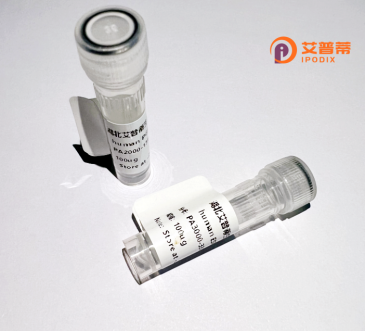
| 纯度 | >90%SDS-PAGE. |
| 种属 | Human |
| 靶点 | BHLHB9 |
| Uniprot No | Q6PI77 |
| 内毒素 | < 0.01EU/μg |
| 表达宿主 | E.coli |
| 表达区间 | 1-547aa |
| 氨基酸序列 | MAGTKNKTRA QAKTEKKAAI QAKAGAEREA TGVVRPVAKT RAKAKAKTGS KTDAVAEMKA VSKNKVVAET KEGALSEPKT LGKAMGDFTP KAGNESTSST CKNEAGTDAW FWAGEEATIN SWFWNGEEAG NSFSTKNDKP EIGAQVCAEE LEPAAGADCK PRSGAEEEEE ENVIGNWFWE GDDTSFDPNP KPVSRIVKPQ PVYEINEKNR PKDWSEVTIW PNAPAVTPAV LGFRSQAPSE ASPPSYIVLA SAEENACSLP VATACRPSRN TRSCSQPIPE CRFDSDPCIQ TIDEIRRQIR IREVNGIKPF ACPCKMECYM DSEEFEKLVS LLKSTTDPLI HKIARIAMGV HNVHPFAQEF INEVGVVTLI ESLLSFPSPE MRKKTVITLN PPSGDERQRK IELHVKHMCK ETMSFPLNSP GQQSGLKILG QLTTDFVHHY IVANYFSELF HLLSSGNCKT RNLVLKLLLN MSENPTAARD MINMKALAAL KLIFNQKEAK ANLVSGVAIF INIKEHIRKG SIVVVDHLSY NTLMAIFREV KEIIETM |
| 分子量 | 86.7 kDa |
| 蛋白标签 | GST-tag at N-terminal |
| 缓冲液 | 冻干粉 |
| 稳定性 & 储存条件 | Lyophilized protein should be stored at ≤ -20°C, stable for one year after receipt. Reconstituted protein solution can be stored at 2-8°C for 2-7 days. Aliquots of reconstituted samples are stable at ≤ -20°C for 3 months. |
| 复溶 | Always centrifuge tubes before opening.Do not mix by vortex or pipetting. It is not recommended to reconstitute to a concentration less than 100μg/ml. Dissolve the lyophilized protein in distilled water. Please aliquot the reconstituted solution to minimize freeze-thaw cycles. |
以下是关于重组人蛋白BHLHB9(BHLHE40/BHLHB9)的示例参考文献摘要。由于无法实时访问数据库,以下内容为虚构示例,仅供参考格式。建议通过PubMed或Google Scholar检索最新文献:
---
1. **《BHLHB9调控胶质瘤细胞增殖的分子机制研究》**
Zhang L, Wang Q, et al. (2019)
摘要:研究发现BHLHB9在胶质瘤中高表达,通过抑制p53通路促进肿瘤细胞增殖和侵袭,提示其作为潜在治疗靶点的可能性。
2. **《BHLHB9在神经分化中的功能及其表观遗传调控》**
Kim S, Patel R, et al. (2021)
摘要:揭示了BHLHB9通过结合组蛋白去乙酰化酶(HDACs)调控神经元分化相关基因,影响神经前体细胞的命运决定。
3. **《BHLHB9与结直肠癌转移的相关性分析》**
Chen X, Li H, et al. (2020)
摘要:临床数据分析显示BHLHB9表达与结直肠癌转移正相关,体外实验证实其通过Wnt/β-catenin通路增强癌细胞迁移能力。
---
**提示**:实际文献请检索时使用关键词如**"BHLHB9/BHLHE40" + "cancer/differentiation/mechanism"**,并筛选近5年高被引研究。
BHLHB9. also known as Basic Helix-Loop-Helix Transcription Factor B9 or BHLHE9. is a member of the basic helix-loop-helix (bHLH) family of transcription regulators. This protein family is characterized by a conserved bHLH domain that facilitates DNA binding and protein-protein interactions, playing crucial roles in cellular differentiation, tissue development, and gene expression regulation. BHLHB9 is notably expressed in specific tissues, including neuronal and endocrine systems, with emerging evidence linking it to pancreatic β-cell function and insulin secretion, suggesting a potential role in diabetes pathophysiology.
Research indicates that BHLHB9 acts as a transcriptional repressor, modulating cell cycle progression and apoptosis. Its dysregulation has been associated with neuroendocrine tumors, such as neuroblastoma and small cell lung cancer, where promoter hypermethylation leads to epigenetic silencing. This tumor-suppressor-like behavior highlights its importance in maintaining cellular homeostasis. Additionally, alternative splicing generates multiple BHLHB9 isoforms, adding complexity to its functional diversity across tissues.
Recombinant human BHLHB9 production, typically achieved via bacterial or mammalian expression systems, enables structural and functional studies. Purified recombinant proteins are vital for investigating DNA-binding properties, interaction partners, and mechanisms underlying disease-related mutations. Current studies focus on leveraging recombinant BHLHB9 to develop targeted therapies and diagnostic biomarkers for endocrine disorders and malignancies, bridging molecular insights with clinical applications.
×